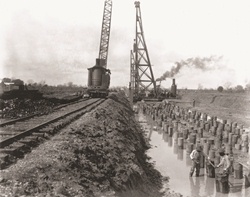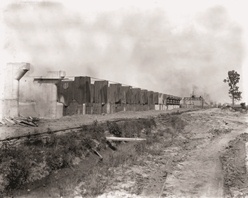
Thousands of wooden pilings were driven to provide a reliable foundation for the structure. |
A series of preliminary investigations were conducted to address the design concerns and ensure an effective and high quality construction project. Three separate studies were performed on-site. The first of these were site and foundation studies to determine the properties of the soil. Piling tests were undertaken to compare the qualities of wooden and concrete pilings.
The tests indicated that long timber piles, in the range of 70 feet, would be quite adequate if sufficient numbers were driven under the structure. Untreated piles were selected after examining the Robert E. Lee Monument foundation in New Orleans, which showed that such piles last indefinitely as long as they are kept below the water table. |
A temporary hydraulics laboratory was constructed on-site to determine the best shape of the weirs and to test various designs for dissipating the energy of water coming over the weir. To accomplish these design objectives, two wooden flumes (channels) were built: the first, a 1/6th scale model of a single spillway gate opening; and the second, a flume of 1/20th scale permitting the modeling of 22 spillway gates. Tests conducted with these models not only established the spillway's design parameters, but also demonstrated the usefulness of modeling in designing large hydraulic structures.

High strength concrete used in the spillway was an engineering advancement.
|
Because of the large quantity of concrete involved in the structure (135,000 cubic yards), it was essential that the concrete mixture produce strong, durable and economic concrete. The Corps established a concrete laboratory to determine optimal mixes of sand, gravel, cement and water quality for the spillway.
Tests from the lab proved critical, resulting in a very high strength concrete with a compressive capacity of 5,000 pounds per square inch. This was a significant advancement for the time, as typical concrete in the 1930s provided only 2,500 to 3,000 pounds per square inch. |
The design and construction of the Bonnet Carré Spillway was completed in just two and a half years. However, the urgency to complete the spillway, following the Great Flood of 1927, did not diminish its quality as an effective and enduring flood control structure. Today, the spillway remains as it was originally constructed; no significant modifications to the structure have been needed.
The Bonnet Carré Spillway is an excellent example of engineering design and construction in the era before "high-tech" solutions, and it is listed on the National Register of Historic Places